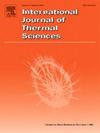Research on mini-channel heat exchangers with honeycomb modular structure: Design principles and convective heat transfer
IF 4.9
2区 工程技术
Q1 ENGINEERING, MECHANICAL
International Journal of Thermal Sciences
Pub Date : 2025-03-06
DOI:10.1016/j.ijthermalsci.2025.109832
引用次数: 0
Abstract
The use of micro/mini channels in heat exchangers can significantly enhance the heat transfer coefficient, reduce equipment size, and lower manufacturing costs. However, challenges such as manufacturing difficulties and scalability limitations remain. To address these issues, this paper proposes a novel assembly structure based on a honeycomb configuration, using modular cores, each containing a bundle of stainless steel tubes with an outer diameter of 3 mm and an inner diameter of 2 mm. A water-to-water heat transfer experiment system was established to investigate the heat transfer and flow resistance characteristics of the heat exchanger within the shell-side Reynolds number range of 200–1400. The results indicate that the prototype exhibits a shell-side heat transfer coefficient five times higher than that of conventional shell and tube heat exchangers, although the shell-side friction factor is correspondingly increased. The tube bundle structure was simplified using a porous media and dual-cell model, and CFD analysis was performed to investigate the mechanism through which the presence of blocking tubes enhances heat transfer performance. Furthermore, the causes of excessive shell-side resistance were analyzed, and an improved structure was designed to effectively reduce shell-side flow resistance. The design principles for this type of heat exchanger were proposed, providing a foundation for the further development of large-scale power heat exchangers.
求助全文
约1分钟内获得全文
求助全文
来源期刊

International Journal of Thermal Sciences
工程技术-工程:机械
CiteScore
8.10
自引率
11.10%
发文量
531
审稿时长
55 days
期刊介绍:
The International Journal of Thermal Sciences is a journal devoted to the publication of fundamental studies on the physics of transfer processes in general, with an emphasis on thermal aspects and also applied research on various processes, energy systems and the environment. Articles are published in English and French, and are subject to peer review.
The fundamental subjects considered within the scope of the journal are:
* Heat and relevant mass transfer at all scales (nano, micro and macro) and in all types of material (heterogeneous, composites, biological,...) and fluid flow
* Forced, natural or mixed convection in reactive or non-reactive media
* Single or multi–phase fluid flow with or without phase change
* Near–and far–field radiative heat transfer
* Combined modes of heat transfer in complex systems (for example, plasmas, biological, geological,...)
* Multiscale modelling
The applied research topics include:
* Heat exchangers, heat pipes, cooling processes
* Transport phenomena taking place in industrial processes (chemical, food and agricultural, metallurgical, space and aeronautical, automobile industries)
* Nano–and micro–technology for energy, space, biosystems and devices
* Heat transport analysis in advanced systems
* Impact of energy–related processes on environment, and emerging energy systems
The study of thermophysical properties of materials and fluids, thermal measurement techniques, inverse methods, and the developments of experimental methods are within the scope of the International Journal of Thermal Sciences which also covers the modelling, and numerical methods applied to thermal transfer.
 求助内容:
求助内容: 应助结果提醒方式:
应助结果提醒方式:


